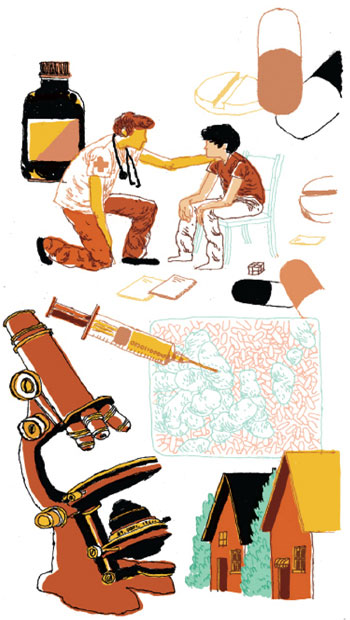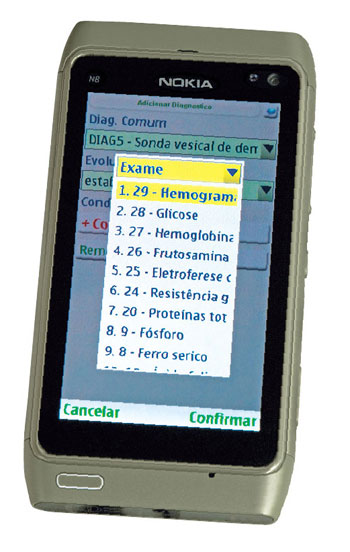 MATEUS ACIOLI
MATEUS ACIOLIThe system created at IME is relatively simple. Before leaving the healthcare center, the physician accesses the SaguiSaude platform (the healthcare center’s information system) via the internet and instructs the software to prepare a file with detailed information about the patients that are to be visited that day. Then, using the wi-fi network, the doctor downloads into a smartphone this data containing socioeconomic information about the patients, the history of visits, details of the medication they take and results of clinical tests, and other information. During the visit, besides accessing the main information about the patients, the physician can consult medication lists and the international catalog of illnesses, as well as filliing out electronic forms, dictating texts and recording voice memos, which are stored in a data file. Upon returning to the healthcare center, the doctors upload all of this information into the SaguiSaude platform, automatically updating the patients’ records.
“Borboleta is a tool that simplifies and speeds up healthcare. The professionals have prompt access to data and can also carry out surveys on epidemiological information faster, by cross referencing data from several patients,” states Professor Fabio Kon, from the Computing Science Department of IME, and coordinator of the project. Borboleta’s target audience is people who are unable to go to healthcare units and who must be visited at home, such as elderly people who find it difficult to move about, stroke victims, paralyzed individuals and those who have just undergone surgery. The Brazilian homecare programs, though they represent progress in the healthcare field, share certain problems, such as loss of information in the transcription of data from paper forms into computerized systems, delays, keyboarding errors, the re-inputting of information in several systems and difficulties analyzing the data and obtaining strategic information. These problems can cause inefficiencies, loss of care quality and a lack of information to make decisions that might improve the use of healthcare resources.
 MATEUS ACIOLI
MATEUS ACIOLIBesides the crucial participation of physicians and nurses from the USP School-Health Center, such as Professor José Ricardo de Mello Brandão, Borboleta’s development also relied on partners from other domestic and foreign institutions. The processing and voice-recognition expert Rebecca Bates, a researcher at the State University of Minnesota, in the United States, spent an entire year, from 2009 to 2010, at IME/USP, collaborating on this project. Currently, both she and Kon are co-advisors of a master’s degree candidate whose aim is to develop mobile phone tools for recognizing spoken Portuguese. The idea is to incorporate this advance into Borboleta, enabling voice memos to pass automatically into the written version. Another partner in this project is the team of Professor Arlindo Flavio da Conceição, from the Science and Technology Institute of the Federal University of São Paulo (Unifesp) at São José dos Campos, responsible for the development of a multimedia resources suite that comprises a voice recorder plus a video and photo camera, not yet incorporated into the software. The team’s idea is to provide Borboleta with a multimedia database, enabling physicians to take patients’ pictures and record images.
The program, according to Kon, is a low-cost solution. “The software’s cost is zero and the hardware is relatively inexpensive. You also don’t need 3D web access [via mobile handsets], which would be expensive. This way, the solution’s total cost is affordable for the healthcare centers of SUS, the Single Healthcare System,” he says, adding that he is unaware of similar systems in Brazil or abroad. “There are systems focusing on a given hospital and others for home use, which are more limited.”
 MATEUS ACIOLI
MATEUS ACIOLI
Besides providing access to patients’ data and health history during home visits and offering full storage capacity of the information collected, a key Borboleta benefit for healthcare professionals is the possibility of preserving and mining data, the topic of a doctoral project that was started recently in the research group. According to Kon, with Borboleta, there is no loss of information, as happens with paper; the data can be accessed more easily at any time and with the help of data mining tools, a process that resorts to statistical techniques, artificial intelligence and pattern recognition to explore large amounts of information, such as association rules or time sequences, to identify systematic relations among variables. For instance, the system might automatically “search” the records of 10 thousand patients over the last 10 years look for repetitive patterns of occurrences and thereby reveal that it is common for patients with Aids and Chagas’ disease to have extra complications due to these two illnesses. Or, alternatively, that most patients that had a given virus went on to develop kidney complications for two years. “The computer discovers associations that we don’t realize exist. These discoveries might lead to proactive attitudes among healthcare administrators when treating such patients, to an increase in the ratio of early detection of critical pathologies and to the prevention of new diseases,” states Kon.
The current Borboleta version is still a prototype and will require thousands of hours of programming to become a reliable commercial system that can be extended to other healthcare units and be broadly used within SUS. This preparation of the system is being conducted by Infomobile, a startup concern created four years ago by two former students in USP’s Master’s Degree Program in Computer Science, who were members of the project’s research group. “The company’s initial idea – and its focus to date – was to develop innovative projects in the mobile computing and applications field that might speed up processes and decision-making with the recovery of data at any time and in any place,” states Vladimir Rocha, one of the Infomobile partners – the other partner is Eduardo Guerra.
The focus of the second Borboleta generation is the Family Healthcare Program. At present, Infomobile, which is being incubated in the Center for Innovation, Entrepreneurship and Technology (Cietec) is partnered by Unifesp’s Program of Basic Care and Family Health (PABSF) and the USP Medical School Samuel Pessoa Health-School Center in the development of the technology. In November 2010, the company was selected by Finep, the Studies and Projects Finance Agency, to get funding from CT-Saúde (the Healthcare Sector Fund), which is earmarked for innovative scientific research and technological development of projects, processes and services applied to tele-health and tele-medicine environments. These resources, in the order of R$800 thousand, are to be used to develop the next Borboleta generation. “As soon as the money is released, we’ll get a usable version within six months, to be tested with some of the family healthcare teams with whom we have had contact already. After 18 months of working on the project, we’ll get the system ready for the Family Healthcare teams to use throughout Brazil,” says Rochas.
As the system that is being developed is to be used nationwide, the company believes that the establishment of collaborating institutions might be the best way of fully disseminating this technology quickly and in places where it might not get to otherwise. “Our business model foresees this situation by making use of free software, which is aligned with the views of the federal government, enabling the transfer of technology to institutions, which would then be able to install and personalize the software without depending on a single supplier,” he states. At the end of the project, the team’s objective is to make the software available in the Brazilian Public Software portal, thus increasing the possibility of its being adopted by different state administrations.
The Project
Project Borboleta: Integrated mobile computing system for home healthcare visits (nº 07/54479-4); Type Regular Research Awards – Microsoft Agreement; Coordinator Fabio Kon – USP; Investment R$ 138,000.00 (FAPESP) and R$ 138,000.00 (Microsoft)